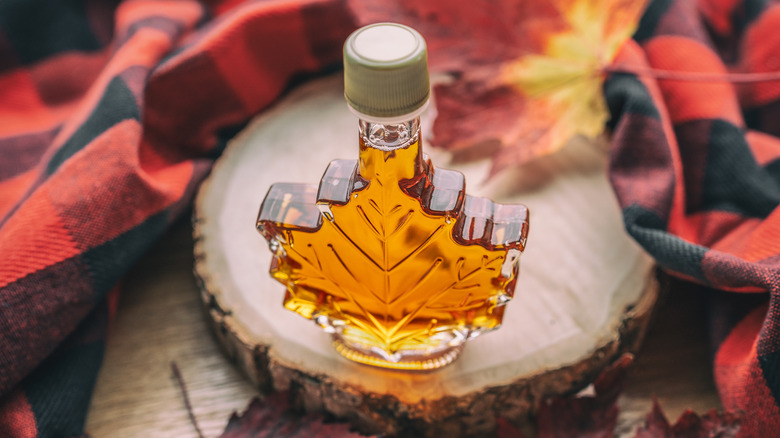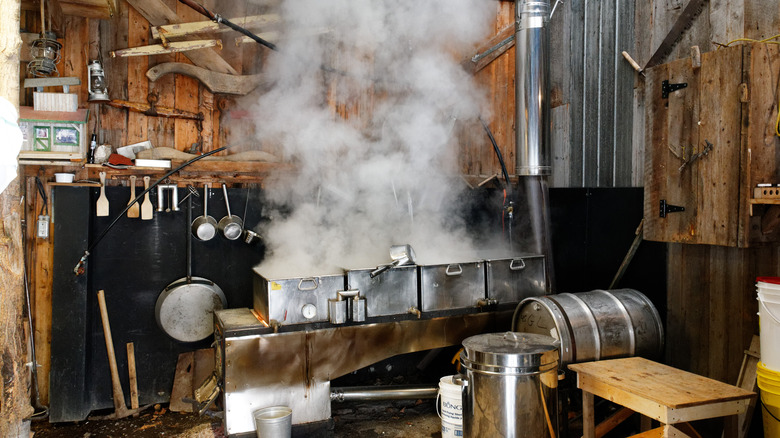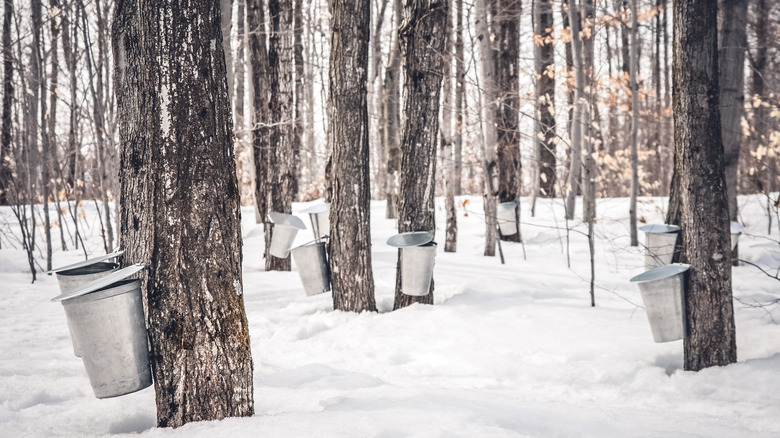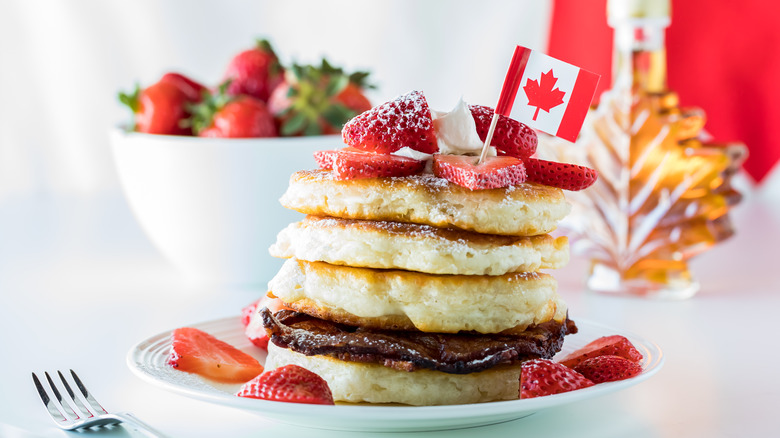Most Of The World's Maple Syrup Comes From This Country
Whether you drizzle it or pour it in a steady stream, maple syrup is the perfect sweet addition to breakfast and brunch foods — or even savory foods like a baked brie. And maple syrup can be more than a bottle filled with amber liquid you keep in the refrigerator, according to Pure Maple From Canada. The site touts many other maple syrup-based products, including maple butter, maple taffy, maple sugar, and maple spirits.
But don't be fooled — just because a bottle of golden liquid in the breakfast foods aisle of the grocery store says syrup, don't assume it contains any maple syrup. Bottles of authentic maple syrup list only one ingredient, while pancake syrups can contain high-fructose corn syrup, cellulose gum, artificial sugars, and caramel color (via Allrecipes). And while both are sweeteners that should be enjoyed in moderation, pure maple syrup has some nutritive value; it has minerals and antioxidants, including calcium, potassium, iron, zinc, and manganese, according to Healthline. Maple syrup also contains natural sucrose (about 60 grams per 80 milliliters), which doesn't affect changes in blood sugar as quickly as the refined sugars in other syrups.
A long history
Maple syrup has a long history in North America, where indigenous people originally enjoyed its natural sweetness. According to Taste of Home, the northeastern U.S. indigenous people began making syrup in the 1600s. They would collect maple sap, which was thin and faintly sweet, and boil it down into a sugary, viscous liquid. It's not known which Native American tribe was the first to make maple syrup, but many share an origin story in which a god or tribal prince punished those lazily drinking the sweet nectar straight from the tree by diluting what could be drawn, per Maple Valley Syrup.
When European settlers arrived, they learned how to make maple syrup from tree sap and continued to change and modernize the process. According to Time, maple syrup became an additional income source for dairy farmers starting in the 17th century. And since maple trees were plentiful, it became a less expensive way to sweeten their foods compared to sugar and different types of molasses, which were imported.
Maple syrup production
The way that maple syrup is made has changed over the years. According to Time, the early European settlers who first began to collect maple tree sap would drill holes in trees and use buckets to collect the sap that would flow out of the trees on spring days when it was 40 degrees, and the night before the temperature was below freezing. The collected sap would be combined into one pot and then heated up to boil off the water. To make one gallon of maple syrup, it takes 40 gallons of sap because the sap is 98% water. The modern way that sap is collected is by using a tube to connect the plastic spouts to large tanks.
Generally, the time period most suitable for maple sap collection is late February to early April, reports Taste of Home. And not all maple trees are capable of producing the right kind of sap needed for syrup. There are 13 suitable species of maple trees which include sugar maple, black maple, and red maple, among others. Once the maple syrup is made, makers grade them based on color, clarity, density, and flavor (via Vermont Maple Sugar Makers). These categories are: golden color with a delicate taste, amber color with rich taste, dark color with robust taste, and very dark color with a strong taste.
Top producer
Canada has a red maple leaf on its flag for a reason. The North American country's woods are filled with maple trees used for making maple syrup. According to Maple From Canada, 71% of the world's maple syrup comes from Canada; and of the maple syrup that Canada produces, 91% of that comes from the province of Quebec. In fact, Quebec alone produces 7,989,000 gallons of maple syrup annually, per Taste of Home. There are 8,600 maple syrup businesses in Canada, 7,400 of which are located in Quebec. With maple syrup production being so prominent in the province, it has become a big part of the local culture, according to Food Nouveau. It is incorporated into many regional dishes, including the hard-times dessert pouding chômeur.
As the world's largest producer of maple syrup, Canada exports its famous product to about 50 countries, according to Maple From Canada. These exports amounted to 12.5 million pounds in 2017, its biggest importer being the U.S. Whether you enjoy maple syrup poured on waffles, used for a glaze for bacon, or in the form of candy, it's very likely that a tree in Canada helped in its creation.



